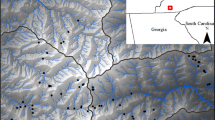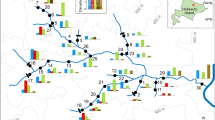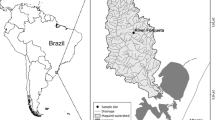Abstract
Distribution patterns of stream biota are the result of complex interactions between individuals and their surrounding environment. Determining the spatial scale by which an organism is most influenced is paramount to understanding distribution patterns. Using a multi-scale approach, we investigated factors influencing habitat associations of larval Ambystoma barbouri (streamside salamander) and Eurycea cirrigera (southern two-lined salamander) in three Kentucky headwater streams. We used likelihood ratio G tests to identify associations between species and mesohabitat (i.e., runs, riffles, and pools), and we used microhabitat variables to predict the presence and abundance of salamanders via a priori multiple regression modeling. Ambystoma barbouri presence and abundance were influenced by conditions at micro-scales, which in turn dictated mesohabitat associations. Eurycea cirrigera were also influenced by microhabitat variables, but displayed associations to A. barbouri presence in late spring. Associations of larval salamanders to mesohabitat and microhabitat parameters shifted from early to late spring, likely in response to changes in developmental stage. The multi-scale approach of our study improved our understanding of complex relationships between larval salamanders and their surrounding environment in headwaters, and underscored the importance of (1) research investigating multiple spatial and temporal scales and (2) heterogeneous in-stream habitat to headwater biota.








Similar content being viewed by others
References
Arnold, T. W., 2010. Uninformative parameters and model selection using Akaike’s Information Criterion. Journal of Wildlife Management 74: 1175–1178.
Bain, M. B., 1999. Substrate. In Bain, M. B. & N. J. Stevenson (eds), Aquatic Habitat Assessment: Common Methods. American Fisheries Society, Bethesda, MD.
Barbour, R. W., 1971. Amphibians and Reptiles of Kentucky. University Press of Kentucky, Lexington, KY.
Barr, G. E. & K. J. Babbitt, 2002. Effects of biotic and abiotic factors on the distribution and abundance of larval two-lined salamanders (Eurycea bislineata) across spatial scales. Oecologia 133: 176–185.
Bruce, R. C., 1986. Upstream and downstream movements of Eurycea bislineata and other salamanders in a southern Appalachian stream. Herpetologica 42: 149–155.
Burnham, K. P. & D. R. Anderson, 2002. Model Selection and Multimodel Inference: A Practical Information-Theoretic Approach. Springer, New York, NY.
Davic, R. D. & H. H. Welsh Jr., 2004. On the ecological role of salamanders. Annual Review of Ecology, Evolution, and Systematics 35: 405–434.
Doi, H. & I. Katano, 2008. Distribution patterns of stream grazers and relationships between grazers and periphyton at multiple spatial scales. Journal of the North American Benthological Society 27: 295–303.
Frissell, C. A., W. J. Liss, C. E. Warren & M. D. Hurley, 1986. A hierarchical framework for stream habitat classification: viewing streams in a watershed context. Environmental Management 10: 199–214.
Gustafson, M. P., 1994. Size-specific interactions among larvae of the Plethodontid salamanders Gyrinophilus porphyriticus and Eurycea cirrigera. Journal of Herpetology 28: 470–476.
Holomuzki, J. R., 1991. Macrohabitat effects on egg deposition and larval growth, survival, and instream dispersal in Ambystoma barbouri. Copeia 1991: 687–694.
Keitzer, S. C. & R. R. Goforth, 2013. Spatial and seasonal variation in the ecological significance of nutrient recycling by larval salamanders in Appalachian headwater streams. Freshwater Science 32: 1136–1147.
Lowe, W. H., 2005. Factors affecting stage-specific distribution in the stream salamander Gyrinophilus porphyriticus. Herpetologica 61: 135–144.
Martin, S. D., B. A. Harris, J. R. Collums & R. M. Bonett, 2012. Life between predators and a small space: substrate selection of an interstitial space-dwelling stream salamander. Journal of Zoology 287: 205–214.
Mazerolle, M. J., 2013. Model selection and multimodel inference based on (Q)AIC(c) [available on internet at http://www.cran.r-project.org/web/packages/AICcmodavg/AICcmodavg.pdf]. Accessed 25 March 2013.
McIntosh, A. R., B. L. Peckarsky & B. W. Taylor, 2004. Predator-induced resource heterogeneity in a stream food web. Ecology 85: 2279–2290.
McIntyre, P. B., A. S. Flecker, M. J. Vanni, J. M. Hood, B. W. Taylor & S. A. Thomas, 2008. Fish distributions and nutrient cycling in streams: can fish create biogeochemical hotspots? Ecology 89: 2335–2346.
Milanovich, J. R., 2010. Modeling the current and future roles of stream salamanders in headwater streams. Unpublished doctoral dissertation. University of Georgia, Athens.
Montgomery, D. R. & J. M. Buffington, 1997. Channel-reach morphology in mountain drainage basins. Geological Society of America Bulletin 109: 596–611.
Munshaw, R. G., W. J. Palen, D. M. Courcelles & J. C. Finlay, 2013. Predator-driven nutrient recycling in California stream ecosystems. PLoS One 8: e58542. doi:10.1371/journal.pone.0058542.
Naiman, R. J. & H. Décamps, 1997. The ecology of interfaces: riparian zones. Annual Review of Ecology and Systematics 28: 621–658.
Petranka, J. W., 1984a. Incubation, larval growth, and embryonic and larval survivorship of smallmouth salamanders (Ambystoma texanum) in streams. Copeia 1984: 862–868.
Petranka, J. W., 1984b. Ontogeny of the diet and feeding behavior of Eurycea bislineata larvae. Journal of Herpetology 18: 48–55.
Petranka, J. W., 1984c. Breeding migrations, breeding season, clutch size, and oviposition of stream-breeding Ambystoma texanum. Journal of Herpetology 18: 106–112.
Petranka, J. W., 1998. Salamanders of the United States and Canada. Smithsonian Institution Press, Washington, D.C.
Petranka, J. W. & A. Sih, 1986. Environmental instability, competition, and density-dependent growth and survivorship of a stream-dwelling salamander. Ecology 67: 729–736.
Petranka, J., A. Sih, L. B. Kats & J. R. Holomuzki, 1987. Stream drift, size-specific predation, and the evolution of ovum size in an amphibian. Oecologia 71: 624–630.
Poff, N. L., 1997. Landscape filters and species traits: towards mechanistic understanding and prediction in stream ecology. Journal of the North American Benthological Society 16: 391–409.
Rabeni, C. F., K. E. Doisy & D. L. Galat, 2002. Testing the biological basis of a stream habitat classification using benthic invertebrates. Ecological Applications 12: 782–796.
Semlitsch, R. D. & J. R. Bodie, 2003. Biological criteria for buffer zones around wetlands and riparian habitats for amphibians and reptiles. Conservation Biology 17: 1219–1228.
Sih, A., L. B. Kats & R. D. Moore, 1992. Effects of predatory sunfish on the density, drift, and refuge use of stream salamander larvae. Ecology 73: 1418–1430.
Smith, S. & G. D. Grossman, 2003. Stream microhabitat use by larval southern two-lined salamanders (Eurycea cirrigera) in the Georgia Piedmont. Copeia 2003: 531–543.
Sokal, R. R. & F. J. Rohlf, 1995. Biometry: The Principles and Practices of Statistics in Biological Research, 3rd ed. W. H. Freeman and Company, San Francisco, CA.
Storfer, A., 1999. Gene flow and population subdivision in the streamside salamander, Ambystoma barbouri. Copeia 1999: 174–181.
Torgerson, C. E., D. M. Price, H. W. Li & B. A. McIntosh, 1999. Multiscale thermal refugia and stream habitat associations of Chinook salmon in northeastern Oregon. Ecological Applications 9: 301–319.
Vanni, M. J., 2002. Nutrient cycling by animals in freshwater ecosystems. Annual Review of Ecology and Systematics 33: 341–370.
Wells, K. D., 2007. The Ecology and Behavior of Amphibians. University of Chicago Press, Chicago, IL.
Woods, A. J., J. M. Omernik, W. H. Martin, G. J. Pond, W. M. Andrews, S. M. Call, J. A. Comstock & D. D. Taylor, 2002. Ecoregions of Kentucky (color poster with map, descriptive text, summary tables, and photographs): (map scale 1:1,000,000). United States Geological Survey, Reston, VA.
Acknowledgments
This work was supported by the Kentucky Society of Natural History and Eastern Kentucky University’s Department of Biological Sciences and University Research Committee. We thank L. Kats, L. Naselli-Flores, and an anonymous reviewer for their helpful comments and suggestions. Our thanks go to D. Brown and A. Braccia for input on study design, A. Phillips, S. Lundsford, and T. Morris for assistance in data collection, and to M. Guidugli, C. St. Andre, S. King, J. Godbold, and B. Huron, whose comments assisted in the development and execution of this project. Research was performed under the Eastern Kentucky University Institutional Animal Care and Use Committee protocol No. 04-2012.
Author information
Authors and Affiliations
Corresponding author
Additional information
Handling editor: Lee B. Kats
Electronic supplementary material
Below is the link to the electronic supplementary material.
Rights and permissions
About this article
Cite this article
Yeiser, J.M., Richter, S.C. Microhabitat conditions influence mesohabitat associations and distribution of larval salamanders in headwater streams. Hydrobiologia 751, 175–187 (2015). https://doi.org/10.1007/s10750-015-2185-5
Received:
Revised:
Accepted:
Published:
Issue Date:
DOI: https://doi.org/10.1007/s10750-015-2185-5




